The Sky This Month - April 2020
Venus, dominating the evening sky, will glide through the Pleiades star cluster at the beginning of the month and it will be stunning. Use whatever you have: eyes, binoculars, or telescope. For the early birds, there is a spectacular display taking place with Mars, Saturn, and Jupiter in the morning sky. The Moon will join them on April 14 for a couple of days. Photo op! For deep sky objects, we have suggestions in Hydra and Leo. There are also three comets we might try for, yes, three!
preamble
Blake Nancarrow delivered an online presentation of The Sky This Month on 1 April 2020. He prepared his usual month-at-a-glance calendar covering the period. You may view or download and print the colour calendar PDF file.
- TSTM 202004 calendar (v2), 470 KB, PDF
All these materials accompany the live stream and recorded video available on the RASC Toronto Centre YouTube channel.
All photos and graphics copyright the respective owners.
If you are working on a RASC observing programme (perhaps to achieve a certificate), we include targets from Explore The Universe, Explore the Moon, Messier, and the RASC Finest NGCs. See https://rasc.ca/certificate-programs for more information. We also refer to Herschel 400, Halton Arp, and Caldwell objects. Many details of objects and events and phenomena are noted in the RASC Observer's Handbook.
observing lists
The suggested targets for this TSTM were collated into observing lists for a couple astronomy software apps with planning capabilities. You may download a file and install it in your device or computer so to have a list of suggestions when at the telescope or otherwise outside.
- SkySafari: TSTM2004.skylist, 6 KB, text
- SkyTools version 3: TSTM2004_st3.stx, 1 KB, binary
(ST3 files can be imported into ST4) - Excel: TSTM2004.xls, 47 KB, binary
Note: Files stored on Blake's web site under the Computer Ease domain.
the Sun
Our local star is in Pisces for April 1 but enters the constellation of Aries on the 18th. Having recently passed through equinox of course the days are getting longer.
beginning of the month
- Sunset 19:47, Twilight ends 21:25.
- Twilight begins 05:17, Sunrise 06:54.
- That's almost 13 hours of daylight.
end of the month
- Sunset 20:22, Twilight ends 22:13.
- Twilight begins 04:16, Sunrise 06:07.
- That's over 14 hours of daylight.
Want to monitor the positions and characteristics of the Sun, planets of the solar system, comets, etc.? For your Windows and Macintosh computer, download free Stellarium. For your mobile device, visit the online store to get SkySafari.
https://skysafariastronomy.com/
the Moon
We will enjoy two first-quarter Moon phases this month, on the first and last days of April 2020.
Full Moon will occur on the 7th. The Saanich know this as the Sxánel or Bullhead moon reminding us that strong winds are coming, the swallows will return, and it is a good time to catch bullhead fish.
This is followed by 3rd quarter on April 14. Some call that "last quarter" but I believe that is poor terminology which can confuse matters when trying to understand how our celestial neighbour moves.
The "new" Moon occurs on the 22nd. Of course, when there's no moonlight around, that's a good time to go for galaxies and diffuse nebula in your telescope. Or fickle comets! The timing with respect to the Lyrid meteor is perfect this year with the shower peaking at this time.
The International Space Station will fly in front of the Moon on Apr 4. The ground track for this event is very narrow and will now be visible for a small number of people in Toronto. Visit https://calsky.com/ for timing and path information. Also, remember this is a very brief event, about 1/4 of a second. Blink and you'll miss it.
On 14 through 16, the Moon will team up with morning planets making for a very picturesque scene. Even if you're not an early-morning person, and maybe you don't have to get up early to drive to work, I encourage you to set an alarm and have a look. It'll be worth it. For a fun photographic project, set your camera up in the same position with the same settings, and take a photo every day. Left to right (or east to west--no, that's not a typo) the planets are orange Mars, beige Saturn, and sparkling Jupiter. You'll note Mars is, like the Moon, moving rapidly eastward. In fact, Mars moves into Capricornus on April 1. On April 9 and 10, Mars will appear the same distance from Saturn as Jupiter is, flanking the ringed world.
Later in the month, 25-26, in the evening sky, as the young Moon climbs above the western horizon, it will overtake brilliant Venus.
Finally, on April 29, there's a chance to see Lunar X. At lunar coordinates (25.5 south, 1.1 east) just northwest of the crater Werner, between craters Purbach, La Caille, Blanchinus, and Werner, when the Sun is about 1½° above the lunar horizon, the ridges of craters lit and in shadow seem to form an X-shape. By my calculations, this will begin in the evening of Apr 29 at 8:24 PM Eastern Daylight Time, peak at 10:44 PM, and conclude at 1:04 AM.
Venus
The second planet in the solar system is near its maximum angle (elongation) from the Sun which places it very high in the evening sky. And through a combination of its size and illumination, it reaches its maximum brilliance late in the month. You can't miss it.
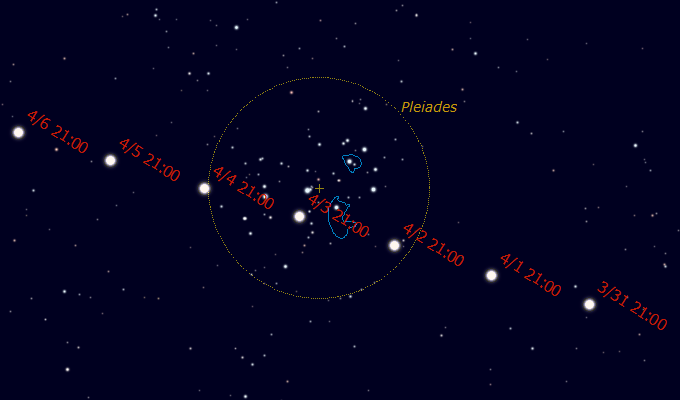
The diagram above it rotated! Up is to the left; down is right.
Now, something to do immediately, is to watch Venus as it slides through the Subaru. Tonight (April 1) Venus will be about 1 degree from the Pleiades star cluster, down and right, or to the south-west. On the 3rd, it will mingle among the blue-white stars. Themselves, these stars dazzle; however, they will be overwhelmed by the planet. Naked eye, you might not be able to see any of the Seven Sisters. Use binoculars or a small telescope to ensure you can see the stars. Keep watching. In the telescope, you'll be able see the planet moving slowly against the tapestry of the heavens. April 4, Venus will be exiting the area and a day later, well to the east.
We used to think Venus could only reach magnitude -4.0 but we now know it goes brighter. On April 27, it will achieve magnitude -4.7. On that date, the cloud-covered planet will present a crescent shape, not unlike our Moon between new and first quarter. This will be obvious even in a small telescope.
Now here's an exercise for the eagle-eyed observer. Can you see the crescent of Venus without magnification?! People with better than 20-20 vision should be able to detect the size and shape of Venus. It will be 37" to 39" by the end of the month. The Moon, by comparison, is roughly 1800. The maximum angular resolution of the human eye is 28 arc seconds.
And one more Venus activity, a fun day-time experiment. On Sunday 26 April, using the Moon as a guide, in your binoculars, look up and left of the Moon. Can you see Venus in the blue sky?! It will be tiny to be sure but you should see a shimmering, bright, obvious point! Good luck.
Jupiter
In the associated calendar file for this month, we note a number of "Jupiter events." This is where a couple or a few interesting things are happening on or near the gas giant world.
April 7: Moon Callisto emerges from an eclipse by the planet. Moon Ganymede transits in front of the planet. And the Great Red Spot (GRS) transits across the face of the largest world.
12: Moon Io's shadow transit over the cloud tops of Jupiter. Then Io proper transits across planet disc. All while another GRS transit takes place.
27: Ganymede is at elongation, i.e. as far from Jupiter as it can appear. There is another GRS transit. Io will be eclipsed by Jupiter (falls into planet's shadow) while Europa will be occulted (directly blocked by the Jupiter).
Lyrids
The Lyrid meteor shower occurs in April every year, from 16 to 30, peaking on 21 and 22. Debris in outer space from the old comet C/1861 G1 (Thatcher), as it hits the Earth's atmosphere, produces medium strength, medium velocity streaks in the night sky. The Lyrids are reliable with good rates, up to 18 per hour, but rarely make persistent trains. Fireballs have been reported in the past.
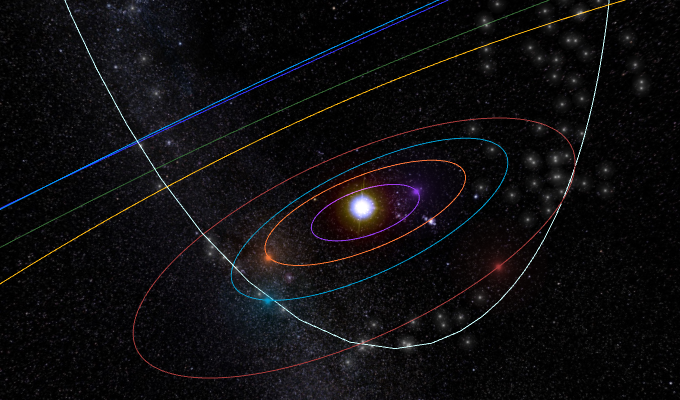
The best part is that this year, 2020, there will be no light from Moon to interfere! Turn off all the lights, ask your neighbours to do that same, get dark adapted and try from the backyard. For best results, get to a dark site away from light pollution. Bundle up and enjoy the sky for 30 or 60 minutes or more.
This shower will appear to emanate from the constellation of Lyra so if you look directly at it, or photograph that part of the sky, meteors will seem to radiate outward from there. But when viewing meteors, it is often better to not look directly at the radiant zone. Take in the whole sky. Then when you see a meteor zip across your field, try tracing it backwards.
Visit the American Meteor Society for more info.
You might spot some early η (eta) Aquarids. They will peak in May...
Speaking of things falling to Earth, I don't think you need to worry about Potential Hazardous Object 52768. On April 29, it will be travelling at a brisk 8.7 kilometres per second. It's big: 2457 metres is size! But it will miss us by about 16 lunar distances or 5.8 million kilometres. Whew!
comets
"Comets are like cats: they have tails, and they do precisely what they want." - David Levy
Amazingly, we have three promising comets visible this month.
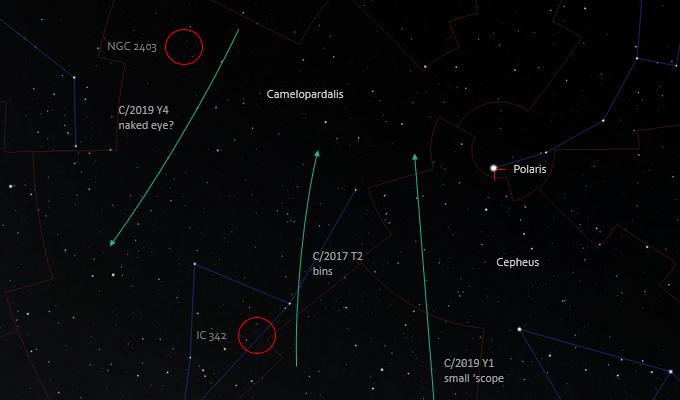
C/2017 T2 starts in Cassiopeia and moves into Camelopardalis. That motion is generally vertically upward assuming you're looking around 10:00 PM. It should be visible in binoculars. It is expected to slowly brighten.
Similarly, C/2019 Y1 is moving upward. It starts deep in the constellation of the Queen, passes through the King's quarters (Cepheus). It too is brightening. Use a small telescope to get it.
Finally, C/2019 Y4 is going the other direction, downward through the faint constellation of the Giraffe. This comet is brightening rapidly. Some are even saying it will reach -1 mag! That will be naked eye! We'll have to wait and see.
Ordinarily you need a sky free from light pollution to tag small dim tantalising comets so avoid the Moon and get to a dark sky location if possible.
Excellent resources for keeping tabs on comets are Aerith by Seiichi Yoshida and Comet Chasing by Greg Crinklaw.
https://cometchasing.skyhound.com/
backyard occultation
Trying to limit your travel and interactions right now? Why don't you attempt an asteroid occultation. This one will fly over your backyard. Just about everyone in the Greater Toronto Area could try this, as well as people living between Toronto and the Bruce Peninsula, from Kitchener and Kincardine to Oshawa and Barrie.
On Apr 15 at 10:23 PM EDT, in a moonless sky, asteroid (38) Leda will block a star in Virgo. The occultation has a rank rating of 100 which is encouraging.
The rock in the solar system has a magnitude of 12.1 while the star is mag 12.3. The drop in magnitude is predicted to be 0.7 for 9 seconds. That's not a huge change but if you're careful you should be able to see that. No problem if video recording the event. The target will be 18 degrees above the horizon so there will be some atmospheric extinction.
Let us know how you did!
For more information, visit Steve Preston's helpful occultation site.
http://www.asteroidoccultation.com/
deep sky targets
Late-March and early-April dates near the new Moon are considered the best times for attempting the Messier Marathon, wherein observers try to view all 110 deep sky objects in the Charles Messier catalogue. It's a little late to try that now. But this reminds us that many of the M objects are still well placed for observing any time in the evening (or pre-dawn morning).
Here is a short selection of targets for your consideration. Our featured constellations are Hydra and Leo.
the lion
There are five Messier objects in the Leo constellation, in two groupings.
Some constellation stick figures leave a lot to the imagination but Leo is fairly evocative. It's easy to find by looking for the backward question mark, often referred to as the Sickle. The lucida (brightest star) is Regulus.
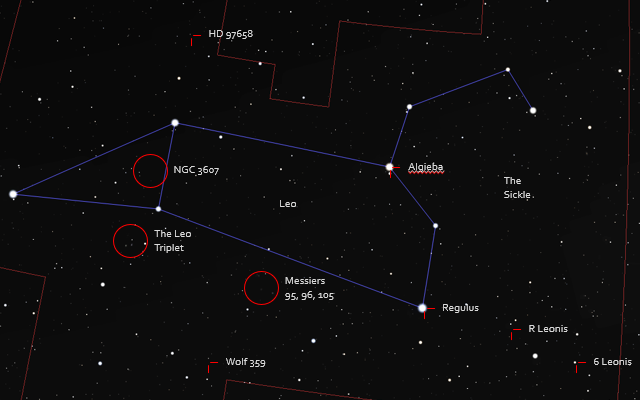
We'll start with the gaggle of galaxies near the belly of the celestial feline. Messier 95, 96, and 105 are within a 2 degree circle and could possible fit in a single field of a very low power eyepiece. That said, you'll want decent telescope aperture to brighten these distant galaxies.
For a little bonus, look for the lenticular galaxy NGC 3384 right beside M105. It's a RASC Finest NGC target and on the Herschel 400 list. Small, dim NGC 3389 will reveal itself in a very large telescope or in long-exposure images. If photographing the 3384 galaxy, look for quasar NGC 3384 U4. It's magnitude 18.9, has a redshift (z) value of 1.11, and light time at 7.0 giga-years!
[Note: SkySafari refers to NGC 3384 as NGC 3371 and 3389 as 3373. SkySafari Plus does not show the quasar but it is near star Tycho 00852-1058 1.]
Near the hindquarters of the big cat, we have the fantastic Leo Triplet. It is comprised of M 65, M 66, and the "Hamburger Galaxy" aka NGC 3628. The entire group was catalogued by Halton Arp as number 317 as they are clearly interacting. 3628 is huge making many wonder how on Earth Mr Messier missed it.
One more galaxy, another RASC Finest, is NGC 3607. In the rump of Leo.
See the Astronomical League for more info on the Herschel 400 programme.
https://www.astroleague.org/al/obsclubs/herschel/h400lstc.html
There are a lot of fun double stars here. Algieba aka γ (gamma) 1 Leonis is a crowd-pleaser at the David Dunlap Observatory, shimmering gold stars, nearly equal in brightness. Of primary interest is the binary pair of stars, the A and B components, in the quadruple system. Current calculations suggest a 619 year period. Presently these stars are separated by 4.5 seconds of arc. Easy in an 8-inch telescope.
Another great double is 6 Leo aka SHJ 107. Much wider than gamma, at 37". Some might describe the stars as bright yellow-orange and dark blue-green. Sissy Haas, a notable double star observer thought the primary "brick-red." She quotes Smyth and Webb: "pale rose tint, purple" and "deep orange, green." The Observer's Handbook says orange and green. What do you think?
See the Washington Double Catalogue for more info. You can do "citizen science" by measuring double stars so to help refine the orbits.
For a slightly more challenging target, monitor R Leo. It's a M-class pulsating variable star that varies in magnitude from 4 to 11 over a period 300+ days.
See the American Association for Variable Star Observers for more info. Again, you can do "citizen science" by measuring variable star brightness.
Fire up the camera and aim to Wolf 359. This dim star, approximately 8 light-years distant, is moving through the sky at 4.7 arc-seconds per year. That's very high "proper motion." Image it frequently, at least once a year, and then make a little movie so to show how the stars are not "fixed in the heavens."
And now a thought-experiment. Imagine visiting exoplanet HD 97658 b. This super-Earth has a diameter 2.3 times that of home. Announced in Nov 2010 and measured in 2012, this exosolar system planet likely has a large rocky core. It either has a deep ocean of water or a thick atmosphere of helium and hydrogen. The gravity is about 1.6 times Terra. The distant world orbits the metal-poor early K1V star every 9½ days. Now, of course, you can't see this exoplanet in your telescope. But you should be able to easily see magnitude 6.3 host star which lies 69 light-years away and let your imagination run...
the water monster
You'll need a good sight line to the south for this next set of targets. Ideally, you want to be able to see down to the horizon.
The enormous constellation of Hydra (the female water snake) stretches from Libra to Cancer, skirting Centaurus and Antila to the south and Corvus and Crater to the north. It hosts three, count 'em, three Messiers.
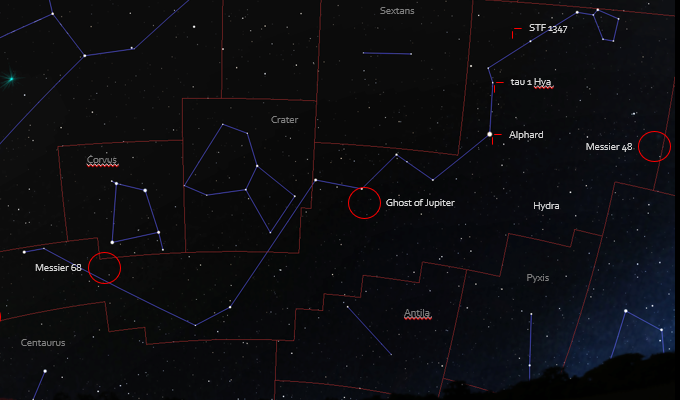
M48 is easy, an open cluster, near the Monoceros border. It might be a somewhat difficult star hop from Procyon. It reveals many equally bright stars. It is large in a small telescope. In the heart is a known double star, HJ 2435, among a pearl string of stars.
More challenging is M68. This is a compact globular cluster, 40 kilo-light-years away. It will like appear very faint, a combination of low attitude, lots of atmosphere, and distance. Keep trying, over more than one night, to get the best conditions.
The hardest target is M83, also known as the "Southern Pinwheel Galaxy." It is very low, near the Centaurus border, in the tail of the monster from the depths. It might be barely detectable for many, despite being a large round galaxy. Time your viewing when it crosses the meridian, that imaginary vertical line rising up from the south cardinal point. That's when the object will be highest in the sky.
Near the belly of the beast, we will find NGC 3242 commonly referred to as the Ghost of Jupiter. This is a relatively big and bright planetary nebula. The expelled material from the old and dying star makes a bright ring in a round cloud. With magnification or a long exposure astrophotograph, you should see the swirling structure within, bright rings inside. It is diffuse at the outer edge, nearly round. This is a RASC Finest target, on the Herschel 400 list, and also indexed by Sir Patrick Moore as Caldwell 59.
Hydra's lucida is orange Alphard, itself a double star. It is very wide but don't use binoculars. Aperture is needed to tag the dim companion. Also known as H 6 111. Look for an intriguing Number 7 shape nearby.
τ (tau) 1 Hya is listed in the WDS as HJ 1167. It is a pleasing double with warm yellow main star and pale orange companion. Widely separated.
Finally, up in the neck, we have HD 81029 or STF 1347. This is a suggestion from the Coldfield list, a good selection of colourful and interesting doubles. White and blue. Wide pair. Similar brightnesses. Note the very faint string or stream of stars to the south-west.
gauge your light pollution
Hey. Let's do more citizen science and gauge light pollution in our communities. Visit the Globe at Night for information and charts and videos and instructions on how to assess your conditions. It can be done quickly and easily with your computer or mobile device.
The next campaign is Apr 14-23, when the Moon is not skewing our results. The GAN team wants us to refer to Leo. Ah, you can "take a reading" when you're chasing down DSOs.
see the ISS flyover
Have you seen the International Space Station fly overhead? It's easy to do, if you're out and looking up at the right date and time.
Evenings passes run from Apr 1-8. After a pause, morning flyovers start Apr 25.
You could try for "dual" trails! Various spacecraft are heading to and departing the orbital outpost which might create two close points of light travelling silently together across the sky.
You might try photographing an ISS pass. It's easy with a tripod. Just hold the shutter open for 30 or 60 seconds.
Visit the Heavens Above web site to get dates and times for your location.
Again, as noted above, the ISS flies in front of the Moon on Apr 4...
humans in space
Speaking of spaceflight, there are lots of things still going on, despite some work stoppages and interruptions.
On Apr 6, the SpaceX Dragon capsule, CRS-20, will depart the ISS and return to Earth.
Apr 9, the expedition 63 crew will launch aboard a Soyuz from Russia, docking with the ISS a few hours later. That will release the expedition 62 team; they'll fall to Earth on Apr 17.
Again, from Russia, on the 25th, a Progress cargo rocket will blast-off to replenish supplies and food for the handful of humans orbiting the planet.
There are some notable anniversaries this April:
1: The United Kingdom space agency opened in 2010.
5: Pioneer 11 was launched for the outer solar system in 1973.
11: Marks the 50th anniversary of the Apollo 13 launch.
12: Trail blazer Yuri Gagarin headed uphill in 1961, the first human in space.
22: The first Canadian spacewalk took place in 2001 courtesy our charming Chris Hadfield.
25: The Hubble Space Telescope was inserted into orbit, from the cargo bay of the Discovery space shuttle, in 1990.
Meanwhile the NASA Space Launch System, Orion, and James Webb Space Telescope projects are on hold.
SpaceX and Boeing were in the midst of testing their human-rated craft but all that will likely be delayed.
The ExoMars rover mission was delayed. When you get bumped from your launch window you have to wait 2 years; it is now slated for 2022.
summary
Briefly, we recap some of the most interesting events for April 2020:
- 1-5: Venus slides through the Pleiades
- 9-10: Saturn splits Mars and Jupiter (morning)
- 14: celebrate Happy Telescope Day
- 14: asteroid Leda occultation, from the backyard
- 14-16: Moon joins morning planets - set the alarm!
- 21-22: Lyrid meteor shower peak
- 24-26: Moon joins Aldebaran and Venus
- 29: see Lunar X
- Mars quickly moves away from Saturn
- meanwhile, Jupiter draws closer to Saturn
- try for comets in the northern sky
- visit Messiers, NGCs, double and variable stars in Hydra and Leo
- help measure light pollution
Lots of thanks are due. Tools used to compile information and make info-graphics include SkyTools, Stellarium, SkySafari, OccultWatcher. Many images were produced with BGO at SMU. Thanks to Betty, Andrew, and Ward for video streaming and recording. Thanks Zoom and YouTube during these "interesting" times! The QR code was quickly produced with https://www.qr-code-generator.com/. Much data was copied from David Mitsky's monthly report, Ron Baalke's space flight web site, the RASC Observer's Handbook, the RASC Calendar, and SkyNews magazine. I thank Andy Beaton for variable star tips. And thanks to president Ralph Chou for supporting this online initiative.
See the author's blog at http://blog.lumpydarkness.com/ for astronomy information, astrophotos, tips and tricks, guides and videos on astronomy software, and so on.
Contact Blake Nancarrow (astronomy at computer-ease dot com) for errors, omissions, questions.
Be seeing you (online).
Oh. One more thing. Turn off the TV...
Blake §

